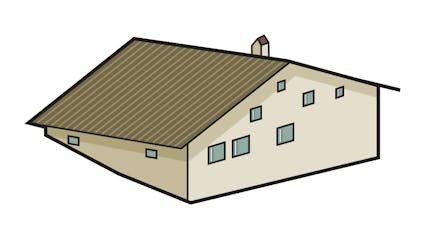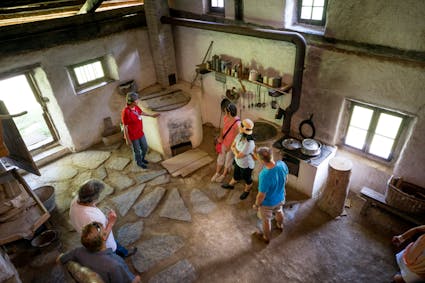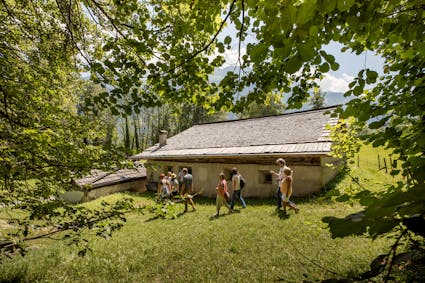1311 – Herder's Hut from Champatsch/Val Mustair, Grisons, 19th Century
According to an inscription next to the entrance, the large alpine building from Champatsch was built in 1825.

Stone Alp Huts
According to an inscription next to the entrance, the large alpine building from Champatsch (1311) was built in 1825. The names of the "Mastrals" (county councillor of the Mustair valley), Jöri Curad, and of the alp overseer, Bastian Bott, are also present on the white plaster background. Inside there are milk and cheese cellars, a cheesemaking room and a parlour from 1950 with a stove. The interiors of alp huts were updated from time to time.

Three Economy Buildings
The big "Schermen" (cow shed, 1312) is striking, providing shelter for cattle in the event of rain or snow. The milking was done here if not in the open. The laterally partially open old building may be from an earlier era – proper stalls are a relatively new development. The stall (1313) in Champatsch is younger and accommodates animals that are unwell. The piggery (1314) with a typical shed roof is quite large. Apparently so much livestock was summered on the alpine commons that the whey from cheesemaking nourished a herd of swine.

Moved Around
The alpine buildings of the Champatsch complex were still in partial use until 1984. The construction of modern alpine stallings with a milk pipeline rendered them redundant. In earlier times there had already been changes at Champatsch: the settlement was repeatedly relocated, probably a result of avalanches. Nearby there are two areas with foundation remains of former buildings.

What’s now to be found at the Champatsch Alpine settlement where these mountain buildings once stood?
Where cows once mooed, dairymen chatted, and milk churns clanked, now there is silence and seclusion.
Ballenberg
Swiss Open-Air Museum
Museumsstrasse 100
CH-3858 Hofstetten bei Brienz
Opening hours Administration
3 November 2025 to 8 April 2026
From Monday to Friday
8.30 am to 11.30 am
1.30 pm to 4.30 pm
Opening hours
9 April to 1 November 2026
10 am to 5 pm daily